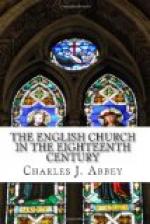an alteration.[74] In regard of the questions specially
at issue with the Nonjurors, he heartily assented
for his own part to the principles of the Revolution,
maintaining ’for a certain truth that as the
law makes the king, so the same law extends or limits
or transfers our obedience and allegiance.’[75]
This being the case, it may at first appear unintelligible
that an ardent nonjuring champion of passive obedience
and non-resistance should assert that ’by none
are these truly Catholic doctrines more openly avowed
than by the present excellent metropolitan of York.’[76]
But Dodwell was correct. Archbishop Sharp, with
perfect consistency, combined with Whig politics the
favourite High Church tenet of the Jacobean era.
He strenuously maintained the duty of passive obedience,
not however to the sovereign monarch, but to the sovereign
law.[77] At the same time he felt much sympathy with
the Nonjurors, and was sometimes accused of Jacobitism
because he would not drop his acquaintance with them,
nor disguise his pity for the sacrifices in which
their principles involved them. When a choice
was given him of two or three of the sees vacated
by the deprivation of the nonjuring bishops, he declined
the offer. He would not allow that there had been
any real unlawfulness or irregularity in their dispossession,
but as a matter of personal feeling he disliked the
idea of accepting promotion under such circumstances.
Although therefore, in many ways, he differed much
in opinion from the Nonjurors, he possessed in a great
degree their attachment and respect. Robert Nelson
was neither the only one of them with whom he was
on terms of cordial friendship, nor was he by any means
the only one whom he persuaded to return to the Established
Communion.
Bishop Smalridge of Bristol should be referred to,
however briefly, in connection with the truly worthy
man who is the main subject of this paper. He
was constantly associated with Nelson in his various
works of charity, especially in forwarding missionary
undertakings, in assisting Dr. Bray’s projects
of parochial lending libraries, and as a royal commissioner
with him for the increase of church accommodation.
Nelson bequeathed to him his Madonna by Correggio
’as a small testimony of that great value and
respect I bear to his lordship;’[78] and to his
accomplished pen is owing the very beautiful Latin
epitaph placed to his friend’s memory in St.
George the Martyr’s, Queen Square.[79] Under
the name of ‘Favonius,’ he is spoken of
in the ‘Tatler’ in the warmest language
of admiring respect, as a very humane and good man,
of well-tempered zeal and touching eloquence, and
’abounding with that sort of virtue and knowledge
which makes religion beautiful.’[80] Bishop
Newton has also spoken very highly of him, and adds
that he was a man of much gravity and dignity and
of great complacency and sweetness of manner.
In reference to this last feature of his character,
it was said of him, when he succeeded Atterbury as




